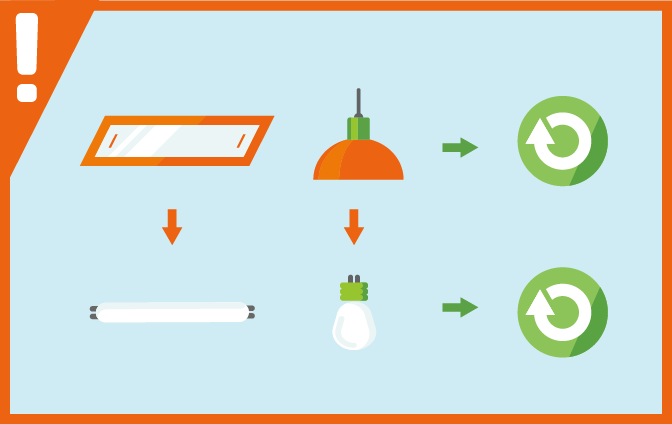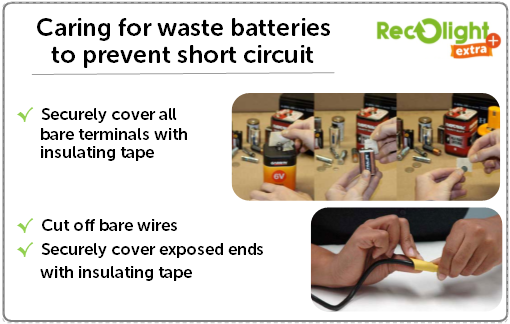MANAGING YOUR SITE
Storing waste lamps, luminaires and batteries
For free collection and recycling your waste lamps must be stored correctly in your containers.
By following this storage advice you can avoid contamination and excessive breakages, and ultimately avoid incurring additional charges.
Your duty of care requirements
Under the WEEE Regulations it is illegal for a business to incorrectly dispose of hazardous waste, or to hand it to a contractor which is not authorised to handle it. Electrical contractors and their customers have a duty of care to make sure their waste is disposed of correctly. This applies to all who:
- Produce or store waste.
- Collect and transport waste.
- Receive waste for recycling or disposal.
Light fittings must have lamps and batteries removed, and all three waste streams sored in separate containers. Incorrect disposal of hazardous waste could land contractors – and their customers – with prosecution, legal costs, reputational damage – and a fine.
Waste must be handed on to an organisation that is authorised to receive that waste. If the contractor disposes of that waste in an illegal fashion, both they, and their customer could be subject to enforcement action by the Environment Agency.
Completing a risk assessment
A risk assessment identifies all hazards that exist on your site and works out how best to control those risks to an acceptable level. It is an important step in protecting both workers and the general public, as well as ensuring compliance. If managed in the correct way, the storage and collection of waste lamps should present a low risk to all who access your site. There is a risk of mercury inhalation when handling and storing waste lamps which is significantly reduced when the lamps remain intact. Following the Recolight storage advice will help to reduce this risk.
You can find more information to help you complete a risk assessment on the Health and Safety Executive website.
Storing waste lamps
 Your Recolight RB19 and RC6/8 containers are for storing gas discharge lamps and LEDs only. They must contain no other type of waste. All packaging must be removed.
Your Recolight RB19 and RC6/8 containers are for storing gas discharge lamps and LEDs only. They must contain no other type of waste. All packaging must be removed.
It is a requirement of the Hazardous Waste Regulations that all types of hazardous wastes are stored separately.
- To avoid breakage, all waste lamps should be stacked neatly and not thrown into containers.
- Wherever possible, linear and non linear lamps should be placed in separate containers.
- Incorrect stacking and breakages will cause problems for our transport company who may be unable to empty the containers in the correct way.
This will increase the possibility of exposure to mercury emissions. - The container lid should be replaced and secured when not in use and unsupervised.
- Lamps and Batteries must be removed from all light fittings and places in their own, separate container.
- Store your container in an area where they cannot be tampered with, damaged or stolen.
- Open collection must points have a level of supervision in the area of the containers during opening hours.
- Don’t accept broken lamps at your collection point, to help minimise the risk to your site.
- If your Recolight container is damaged, please tell us so that we can arrange a replacement.
Correct assembly and use of RB19
DOWNLOAD > RB19 Assembly & loading instructions
DOWNLOAD > Recolight guidance for correct use of RB19 waste lamp container
Special advice for storing xenon & sodium waste lamps
Xenon lamps cannot be accepted at a Recolight network collection point.
- Recolight recommend that xenon lamps are stored separately and not mixed with gas discharge or LED lamps at any time.
- All end of life xenon lamps should be stored and transported in the primary packaging in which they were delivered as new lamps, packed individually in a safe inner packaging.
- Recolight finances the treatment of its members’ obligated xenon lamps. This must be arranged in advance with the Recolight Customer Services Department.
- End users will need to make their own arrangements for transporting the end of life lamps this includes:
- Pre-announcing to the Recolight Customer Services Department all shipments.
- Following all legal requirements and official guidance for the shipment of hazardous lamps.
- Delivering to a recycler nominated by Recolight.
DOWNLOAD > Recolight guidance for handling and storing xenon lamps
DOWNLOAD > Recolight guidance for handling and storing waste sodium lamps



